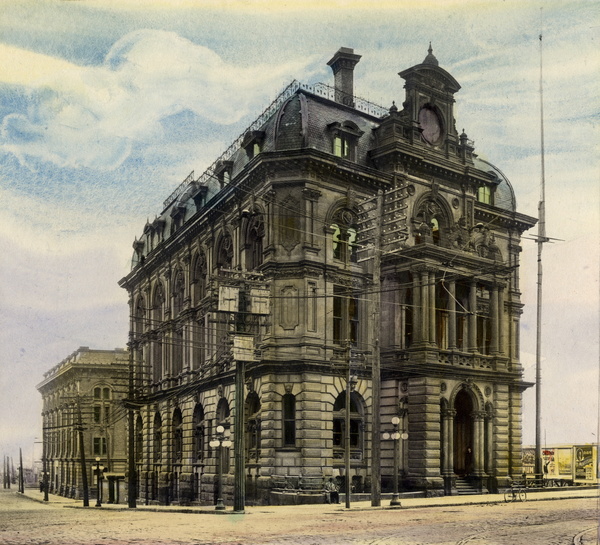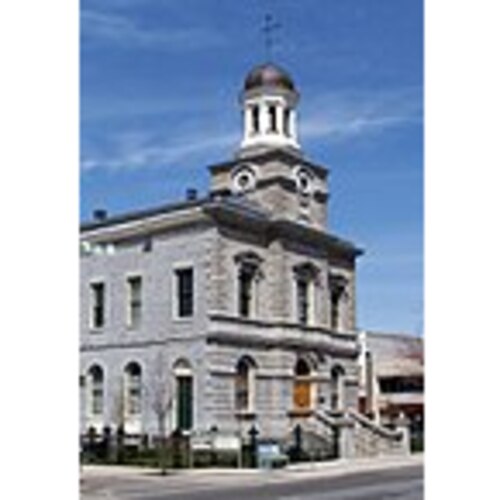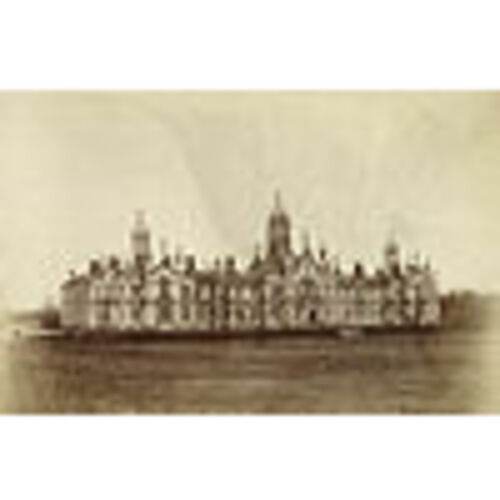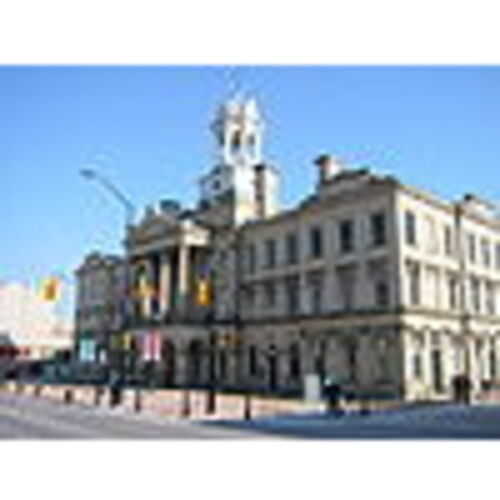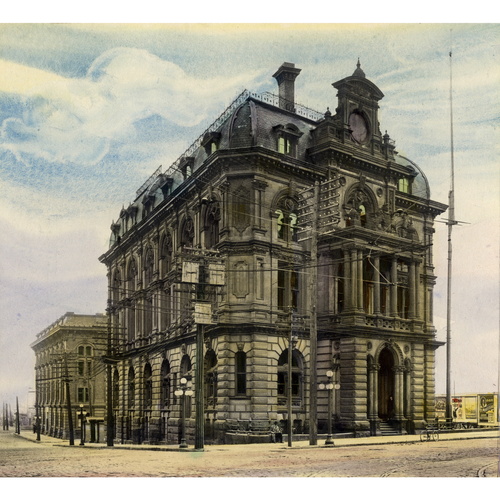TULLY, KIVAS, architect, civil engineer, and civil servant; b. 1820 in Garryvacum, northeast of Port Laoise (Republic of Ireland), son of John P. Tully, a lieutenant in the Royal Navy, and Alicia Willington; m. first 2 Jan. 1844 in Limerick (Republic of Ireland) Elizabeth Drew (d. 1847), and they had two daughters; m. secondly 4 Nov. 1852 in Douro Township, Upper Canada, Maria Elizabeth Strickland (d. 1883), daughter of Samuel Strickland* and widow of Benjamin Beresford, and they had four daughters; d. 24 April 1905 in Toronto.
Kivas Tully received part of his education at the Royal Naval School in Camberwell (London), England, before returning to Ireland for four years of professional training under W. H. Owen, an architect and civil engineer in Limerick. His first job after he qualified was to assist George Wilkinson, architect for the Irish poor-law commissioners, in erecting workhouses. In 1844 Tully left Ireland for the Province of Canada. He arrived on 30 July in Toronto, where his elder brother, John Aspinwall, who had also trained as an architect, was in the office of John George Howard* gaining experience towards his licence as a land surveyor.
It is likely that Kivas Tully came well recommended. In his first year, practising on his own, he secured commissions for the prestigious Bank of Montreal building and the custom-house, both at Yonge and Front streets, Toronto, and for a breakwater at the city’s garrison. Soon, however, the competitive presence of other talented architects, such as Howard, Henry Bowyer Joseph Lane*, William Thomas*, and Thomas Young*, began to tell. Between 1845 and 1850 Tully submitted designs in competition for several major projects, including Toronto’s Commercial Bank of the Midland District, St Michael’s Cathedral (Roman Catholic), Knox’s Church (Presbyterian), St Lawrence Hall, St James’ Cathedral (Anglican), and St James’ parish school, in addition to municipal buildings in Niagara (Niagara-on-the-Lake), Peterborough, and St Catharines. Only at St Catharines did he succeed.
Tully’s luck seems to have turned when he won commissions in 1851 for Trinity College, on Queen Street in Toronto, and the Welland County Court-House at Merrittsville (Welland), and in 1852 for Cobourg’s town hall. All three buildings gave him a chance to exercise his fine sense of formal composition and scale, and to demonstrate his ability to work with assurance in the Classical and Gothic Revival styles then fashionable. He liked to be remembered for Trinity’s Elizabethan Gothic design, although it disappointed him that the buildings were never completed to form a quadrangle or landscaped to his plan. Such was the impact of the design that when the college erected new buildings at Queen’s Park, the architects were asked to model them on the old ones. Now that old Trinity no longer stands, Victoria Hall in Cobourg remains Tully’s best-known work.
The out-of-town jobs gave rise to other commissions: the Prendergast Block in St Catharines for William Hamilton Merritt Jr (1850), a chancel and transepts for St John’s (now St Mark’s) Church (Anglican) at Port Hope (1851), St John’s Church (Anglican) in Thorold (1852), the chancel of St Peter’s Church (Anglican) (1851) in Cobourg, a large mansion there commissioned by Henry Mason (1857), and extensive repairs to St Andrew’s Church (Presbyterian), Niagara, after a tornado in 1854.
Delays in constructing the Welland court-house and Victoria Hall may explain why, in the early 1850s, Tully began to seek civil engineering work and institutional clients in preference to general architectural jobs. In 1853 he took on the tasks of improving Toronto Harbour and planning an esplanade to give access to the wharves after the railways, then under construction across the front of the city, were completed [see Sir Casimir Stanislaus Gzowski*]. In March 1853 he was appointed engineer for the Toronto Harbour Trust, a post he would hold until his death. Later that year city council made him inspecting engineer for the esplanade when his scheme for its development, submitted in competition, failed to secure first prize. During 1855–7 he and Roswell B. Mason, a Chicago engineer, were commissioned by the Toronto Board of Trade to survey the route for a ship-canal (never realized) between Toronto and Georgian Bay. Finally, in 1856, he obtained the position of architect to the Provincial Lunatic Asylum at Toronto, thus beginning his long association with provincial works. By the end of the decade most of his income derived from these appointed positions, and he had few other clients. The Trenton Town Hall (1860) and St Anne’s Church (Anglican) at Brockton, near Toronto (1862), were among his last private commissions.
In January 1868, following confederation, Tully joined the new Ontario Department of Public Works. His first task was to draft its organizing bill, which was passed a year later. Under this legislation he was appointed the department’s architect, engineer, and chief officer; in 1874 the engineer’s position was defined as a separate job. This division of work was realistic in view of the ambitious program of public works then under way, which required the architect’s constant supervision over construction. Projects undertaken by Tully included the Ontario Institution for the Education and Instruction of the Deaf and Dumb at Belleville (1869), an insane asylum at London (1869), the Ontario Institution for the Education and Instruction of the Blind in Brantford (1870), the Central Prison in Toronto (1871), an insane asylum (planned as a hospital for inebriates) on the “mountain” at Hamilton (1873), and the Andrew Mercer Ontario Reformatory for Females in Toronto (1878), as well as major additions to Osgoode Hall (1876). Tully took credit for designing wings added to the Provincial Lunatic Asylum in 1866–70, and he exhibited as his own work a perspective of the Brockville Lunatic Asylum, completed in 1895. Although this evidence is not conclusive, it appears that he was more involved in the development of designs than were his counterparts in the federal Department of Public Works.
The government’s decision in 1880 to build new parliament buildings, in Queen’s Park, should have presented Tully with the most important opportunity of his career. Following approval of the project in principle, he put forward alternative designs, one in a Gothic style reminiscent of the Parliament Buildings in Ottawa and another in an eclectic mix of Second Empire and Classical styles. These, however, were quickly set aside by the government in favour of an architectural competition. The minister responsible, Christopher Finlay Fraser*, commissioner of public works, relegated Tully to an advisory and administrative role, thereby preserving the latter’s reputation during the irregular handling of the matter that followed.
The first round of competition was among 16 architects, 3 of whom were recommended to receive premiums. Next, a second round took place among the half-dozen firms invited back, including only one of the three premiated entrants from the first round. Two of the six competitors – both Canadians – were asked to proceed with working drawings and specifications, which were put out to tender. When each scheme came in over the approved budget, the government allowed three years to elapse before moving forward again. In 1885 it retained Richard Alfred Waite, a Buffalo architect and a judge in the first round, ostensibly to review both tendered proposals. It is hard to accept the bona fides of this assignment when less than a month later, and at least five months before Waite produced any written report, an understanding was in place that he would be appointed architect for the new buildings. There is no record of what Tully thought of all this. Probably he was too loyal and professional either to raise a fuss or to refuse to supervise the ensuing construction, although he must have held his nose as he passed some of Waite’s accounts.
During the last decade of Tully’s career, until he retired in 1896, to be succeeded by Francis Riley Heakes, he saw to completion the Parliament Buildings in 1893, the court-houses at North Bay (1888) and Gore Bay (1889) among other places, and the extensive Brockville asylum.
In keeping with his occupation, Tully was involved from at least 1886 in the formation of the Canadian Society of Civil Engineers, established the following year, and in 1899 he was first president of the Engineers’ Club of Toronto. As well, he had been a member of the Toronto Society of Arts (1847) and the Ontario Society of Artists (1873–76). Apart from his professional interests, he belonged to the Church of England, maintained a lifelong interest in freemasonry, was a charter-member of the Canadian Institute (its founding meeting was held in 1849 in his office), served twice on Toronto City Council (1852 and 1859), was a member of the Public School Board (1854–8), and was a keen cricketer and president (1855) of the Toronto Cricket Club. In 1903 he was awarded the Imperial Service Order. Tully died on 24 April 1905 and was survived by two of his daughters, including Sydney Strickland Tully, a noted portrait and landscape painter.
An exhaustive list of works by Kivas Tully, with sources, has been prepared by the author, and a copy submitted for inclusion in the DCB’s file for Tully.
Several of Tully’s project reports have been published, including Memorandum for the congregation of St. James’ Church . . . (broadsheet, [Toronto?, 1849?]); Engineer’s report in reply to the communication from the mayor of Owen Sound, and the deputation of the county of Grey, on the proposed Toronto and Owen Sound central railway route, with a branch to Saugeen . . . (Toronto, 1857); and Preliminary report of the engineer, on the survey of the various routes for the proposed ship canal, to connect the waters of lakes Huron & Ontario at Toronto, to the president of the Board of Trade; January 22, 1857 (Toronto, 1857). He is co-author, with Roswell B. Mason, of The Georgian Bay canal . . . (Chicago, 1858) and, with William Jarvis McAlpine, of Report to the City Council of Toronto on the proposed water supply by gravitation, from the Oak Ridge Lakes and the rivers Don and Rouge, with map, &c. (Toronto, 1886; another ed., 1887). Tully also assisted in preparing Constitution for proposed Canadian Society of Civil Engineers, provisional committee: Colonel Gzowski, Wm. P. Anderson, Kivas Tully . . . (Ottawa, 1886).
AO, RG 15, E-1, 27, no.1; E-6, folder 12; S-6, 2, no.138; 3, esp. no.309; RG 22, ser.305, nos.5175, 17875. Church of Jesus Christ of Latter-day Saints, Geneal. Soc. (Salt Lake City, Utah), International geneal. index. CTA, RG 1, A, 5 Dec. 1853. British Colonist (Toronto), 30 April 1847. Daily Colonist (Toronto), 9 Nov. 1852: 3. Patriot (Toronto), weekly ed., 10 Feb. 1853. Canadian Architect, 9 (1896): 77; 12 (1899): 117; 18 (1905): 68. Harper, Early painters and engravers. Hist. of Toronto, 1: 357. J. G. Howard, The journal of John George Howard, ed. S. [G.] Morriss (microfiche ed., 7v., [Toronto, 198-?]), 4: 177. RCAA exhibitions (McMann).
Cite This Article
Stephen A. Otto, “TULLY, KIVAS,” in Dictionary of Canadian Biography, vol. 13, University of Toronto/Université Laval, 2003–, accessed December 31, 2025, https://www.biographi.ca/en/bio/tully_kivas_13E.html.
The citation above shows the format for footnotes and endnotes according to the Chicago manual of style (16th edition). Information to be used in other citation formats:
| Permalink: | https://www.biographi.ca/en/bio/tully_kivas_13E.html |
| Author of Article: | Stephen A. Otto |
| Title of Article: | TULLY, KIVAS |
| Publication Name: | Dictionary of Canadian Biography, vol. 13 |
| Publisher: | University of Toronto/Université Laval |
| Year of publication: | 1994 |
| Year of revision: | 1994 |
| Access Date: | December 31, 2025 |


